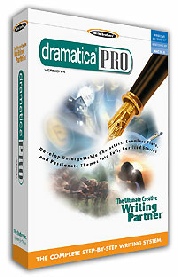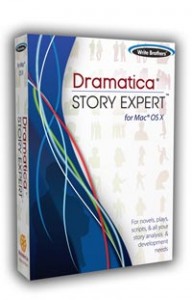One of our earliest attempts to share what we had learned about story theory. This was before we ever considered turning our theories into story development software. When Wordsmith was written, we intended simply to publish a book on the subject. Unlike the eventual book, "Dramatica - A New Theory of Story", Worsmith is a much more conversational work, rather than an academic textbook approach used in Dramatica.
WORDSMITH
(A tool for writing)
He wanted to write a story. But he was confused. Sure, he had ideas: settings, characters, even entire scenes that had just sprung up in moments of inspiration. But he also had big blank areas between the ideas, and no idea how to fill them in.
Where should he begin? How should he organize his story. For that matter, should he organize at all or just jump right in? Being the sort who looks before he leaps, and not wanting to waste time stumbling in the dark, he decided to do some research.
His name was John.
Now, John checked the libraries and bookstores; he subscribed to magazines and periodicals. He took seminars and watched movies and TV. He came away more confused than ever. THIS authority said to do THIS. And THAT authority said to do THAT. But THIS and THAT often disagreed. What was worse, the both seemed to work some of the time. And even worse: most of the time they didn't (at least not completely).
So John, being the sort who doesn't give up, decided to visit other successful writers and see how THEY did it.
His first visit was with a very prolific author who never outlined anything in advance. This fellow just hammered away at the keyboard letting one thought create the next in a never ending chain of thought until THE END. But when John went home to try it himself, he found that his work came out directionless. And although the words were pretty and the scenes grand, his characters wandered about aimlessly, or at best just went along for the ride.
So he visited another successful writer. And this author spent a full year researching and outlining until he knew what every paragraph would be before he wrote a word. But when John tried it, his work lost spontineity and came out dry and lifeless.
He gave the "visit" scheme one more try. This author used a formula for everything he wrote. He simply plugged in his ideas until he had a complete story, then merely expanded them into a finished work. "Wow!", thought John. But, alas, when John tried it, everything came out looking the same, time after time.
He had nearly given up and gone to work for the phone company when a flyer appeared in his mail. It read: "Story problems? Learn the Science of Story Structure from Professor Wordsmith." Included were an address and business hours.
John knocked on the Professor's door. A kindly old man with the firey eyes of a sage greeted John, identifying himself as the Professor in question and invited him in. Unlike the working space of the authors he had visited before, Wordsmith's facility was a modern scientific laboratory, and although devoid of clutter, was filled with a plethora of odd objects in endless variety. "Inspiration!", smiled the Professor, anticipating John's question. Along the back wall were three doorways labelled, "Motivation Room", "Supply Room", and "Play Room". But before John could comment, the Professor rambled on.
"So you want to know about story structure, right? And you want to know why I think I have discovered the end-all system, right? And you want me to prove it to you, right? And then you want to know how to use it yourself, RIGHT?" John could only nod.
"Then let's begin.", he began. "In the past, most systems for understanding stories used INDUCTIVE logic. That is, they analyzed existing works looking for patterns. Then they "boiled down" what they found into rules or laws. Problem is: if you start with "4", how can you tell if it was created by 2 + 2, 2 x 2, 1 + 3, 20/5 or what? You can't! That's why inductive analysis has failed to offer complete explanations of all story situations. Further, it is almost impossible to create a story from scratch using techniques that are geared toward breaking complete works into their component parts."
The professor smiled wryly. HIS system, he explained, relyed on DEDUCTIVE logic. That is, he started from an understanding of where a story "grows" from and combines the elements to arrive at a finished product. The Science of Story Structure, therefore, is a most useful tool in not only analysing existing works, but in creating new ones as well.
But where does a story grow from, wondered John. But before he could pose the question, the professor answered it: Story grows from the mind. The mind trying to solve a problem. We can "reason" our way to a solution, or act solely on our "feelings" about it. We can "accept" pondering the problem, or "ignore" it. That's ALL we can do. No matter what the problem is, there are ONLY THESE FOUR APPROACHES to solving it.
But we are faced with two types of problems in life. Those of the mind, and those of the body. One is posed in the inner world, the other in the physical world around us. But ONLY THESE FOUR APPROACHES exist for us to solve either.
Now the problem of the inner plane is a "moral dilemma". Not to be mistaken as a religious issue, but rather question of basic right or wrong. And the problem of the phyical plane is a question of expediency. Meaning, "What is the best way to accomplish my goal(s)?"
Primary characters represent these four approaches. In the most simple stories each of the primary characters represents one of these four approaches and uses it for both the moral dilemma and the physical quest. In complex stories, as we shall later see, characters may represent more than one of these approaches, or a different one for the moral choice than on the pysical question, or only one for the moral choice, and none for the physical, ad nauseum.
The point being, that once you understand the FOUR APPROACHES, you can mix and match in almost limitless variety to create virtually any story you desire. Hence, we have the "Motivation Room" that contains the "Character Generator", where you make these decisions of combination.
But characters alone have nothing to due, much as pure energy cannot act without something physical to be applied to. So the second room, is the "Supply Room". This is the "plot" room where we pull from an infinite inventory the materials we wish our characters to employ. These materials may be vocations, interpersonal relationships, setting, time, talent, knowledge, posessions... In short, any ability, knowledge, situation, or object that a character can move, manipulate or employ.
But where do they do this? In the "Play Room". This is the "Story" room where it is all put into motion. You see, just as energy cannot accomplish anything without materials to act upon; materials without energy remain motionless. But when you apply characters to plot, story happens.
Of course, play must occur on a playing field. And the exact dimensions and nature of that field are wholly up to the author. Further, the materials from the supply room may be added or removed from the "Play Room" at any time during the story. This room may have objects bolted to the floor that serve as obstacles, or pitfalls, that may or may not be hidden to the characters. And both obstacles and pitfalls may be moved, removed, or changed in nature throughout the play at the whim of the author.
The essential point to remember is: Once you have established a playing field, filled with materials, manipulated by characters, the success of your story depends upon your ability to "call the game".
"But that is just the surface explanation!", the Professor continued. "To learn how to use this system to create your own stories you must examine each concept at it's most elemental level, then combine these basics into the next level of complexity... You wanna learn?", he demanded. John nodded the afirmative, and the Professor threw open the door to the "Motivation Room", motioning John inside...
A bright glow radiated from the beaconing door, but the professor was prepared, handing John a pair of darkened safety glasses and donning a pair himself. "Put these on.", he explained. "This room contains the energy that runs the story machine, much as a nuclear reactor creates the electricty to do physical work."
As his eyes adjusted, John could see that the walls were featureless except for a set of shelves containing four brilliant crystaline cylinders from which burst the intense light. One glowed blue, one red, another yellow, and the last a pure white. John turned to see that the center of the room was dominated by a large machine possessed of four slots, obviously designed to hold the cylinders, and a single fiber-optics line running from the machine through a hole in the wall to the Play Room.
"These", the Professor exlpained, "are the FOUR APPROACHES to solving problems in the "Moral Plane". The blue one is "Reason". A Character driven by reason will approach the moral dilemma with logic and attempt to "figure out" a solution. Similarly, the red cylinder is "Emotion". Obviously, this character lets his feelings soley determine his conclusion on the Moral Plane, even if he flies in the face of logic. Yellow is the color of the Character called "Denial", who won't even consider the moral issue, pretending to be unaware of it, or simply denying it is an issue at all."
"What about the White one?", John inquired. "Ah!", the Professor's voice took on a reverential quality. "The White resepticle contains "Acceptance". This is the Character who accepts the burden of considering the moral question and acts as moderator to the debate. He is colorless in purity, not only because he must consider the other three moral approaches and therefore their primary colors combine into white, but also because he is neutral in his approach until he finally makes the moral decision. It is only this "pure" Character who can make the final, decisive choice."
"Give me a minute!", John stammered, his head reeling.
"Read the One Minute Manager!", retorted the Professor, not unkindly.
"Now, if the only decisions to be made in a story were "moral" ones, this would be enough. But the "real" world intrudes on this simplicity. In story as in life, physical existence demands its due, as neither mind nor meat can survie without the other. So, "plot" decisions occur at every turn, and each must be handled before the story can continue.
"These Four Approaches each have a plot equivalent. Although not identical, these Plot Approaches act in similar manners to their moral kin.
Thursday, April 30, 2009
Subscribe to:
Post Comments (Atom)







No comments:
Post a Comment